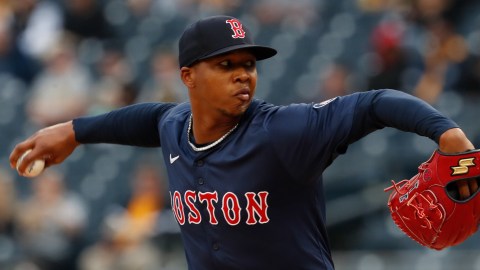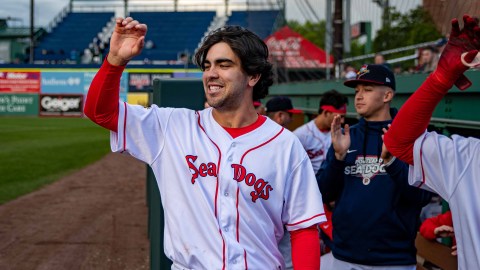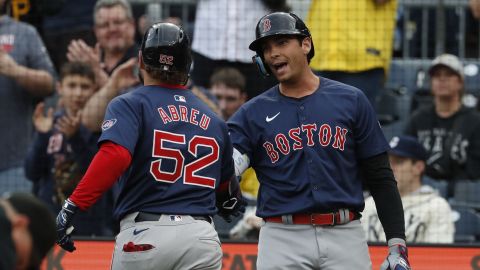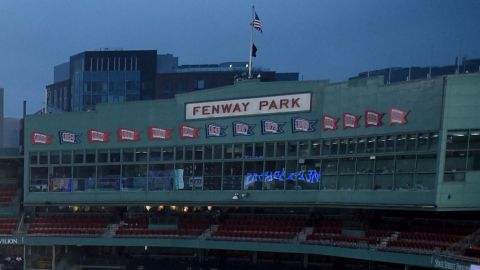 Brennan Boesch is the Frank the Tank of Major League Baseball.
Brennan Boesch is the Frank the Tank of Major League Baseball.
The 27-year-old outfielder, who was released by the Tigers on Wednesday, has had an appetite for streaking throughout his three-year career. When he’s been good, he’s been really good. And when he’s been bad, it’s been unbearable.
Given that level of inconsistency, the Red Sox would be better off filling out their roster from within, even if Boesch’s ceiling is a bit higher than some of the other options currently in place.
Boesch exploded onto the scene with the Tigers in 2010 after being ranked the organization’s 25th-best prospect that spring. In 65 first-half games (267 plate appearances), he posted a .342 average, .397 on-base percentage, .593 slugging percentage, 12 home runs and 49 RBIs as an up-and-coming 25-year-old. It was enough to put him alongside some elite company, and it even led to him being considered an American League All-Star snub.
Then, as is often the case with young hitters, pitchers started adjusting to Boesch, realizing that he has a tendency to swing at anything and everything. That led to the outfielder pulling one of the biggest 180’s imaginable. He followed up his sizzling first half with a second half that saw him post a .163 average, .237 on-base percentage, .222 slugging percentage, two home runs and 18 RBIs in 68 games (245 plate appearances).
Understandably, 2010’s Jekyll and Hyde act generated some concern. Boesch had to again prove himself, as he had essentially undone all that he accomplished in the first half of 2010 with his historically bad second half. Boesch impressed early in 2011, putting up a .306 average, .360 on-base percentage, .490 slugging percentage, 12 home runs and 44 RBIs in 84 first-half games (347 plate appearances). But sure enough, as was the case in 2010, Boesch’s production plummeted off a cliff following the Midsummer Classic, and he posted a .219 average, .288 on-base percentage, .368 slugging percentage, four home runs and 10 RBIs in 31 second-half games (125 plate appearances) before undergoing season-ending thumb surgery.
Boesch’s entire 2012 season was unremarkable, with his highest of highs failing to turn heads and his lowest of lows showing that there are still some significant flaws in his game. Boesch’s biggest asset has always been his bat, but he finished the season with a .240 average, .286 on-base percentage, 12 home runs and 54 RBIs in 132 games. That obviously didn’t sit well with the Tigers, especially since he’s fairly limited defensively — something that had disastrous potential in a very large Comerica Park outfield.
A team will give Boesch a big league opportunity, and some team should, simply to see if he can finally put it all together offensively for a full season. According to various reports, the Red Sox, Yankees, Mets and Astros are all at least considering the idea. In the case of Boston, though, it’d be wise to step back and let someone else take the flier.
Manager John Farrell has a lot to figure out before Opening Day now that it’s looking less and less likely that David Ortiz will be ready. Those questions have the potential to be answered internally, though.
While Boesch is a left-handed hitting outfielder — something the Red Sox made a priority during the offseason — he actually has better numbers against lefties, which makes him a less-than-ideal platoon option to put alongside Jonny Gomes, a right-handed hitter who fares better against lefties.
In addition to the concerning righty/lefty splits, Boesch’s approach at the dish doesn’t exactly coincide with Boston’s 2013 offensive approach, which appears to be largely centered on patience and discipline. Boesch has swung at 39.5 percent of the pitches he’s seen outside the strike zone since 2010, which is the 14th-worst mark in baseball, and pitchers continue to exploit that flaw. Of the pitches Boesch has faced since 2010, 40.9 percent have been outside the strike zone, which is the 10th-highest among qualified big league hitters. That means Boesch needs to make adjustments. Otherwise, it’s hard to envision him ever reaching his maximum potential on a consistent basis, because hurlers will continue to pitch to his weakness.
As far as the bench outfield options that the Red Sox currently have, Jackie Bradley Jr. seems like the popular choice because of his superb defense, immense potential and spring training production thus far. The club could ultimately decide he needs more minor league seasoning, though, in which case Daniel Nava, Lyle Overbay and Mike Carp figure to garner some playing time in the Boston outfield.
Perhaps none of those players are capable of going on a month-long tear, but it’s hard to envision Boesch doing so in Boston either. Boesch likely wouldn’t garner much playing time, and for a guy who has stuck around the bigs because of some streaky hitting, that could decrease his overall value even more.
Have a question for Ricky Doyle? Send it to him via Twitter at @TheRickyDoyle or send it here.
Photo via Flickr/Keith Allison




